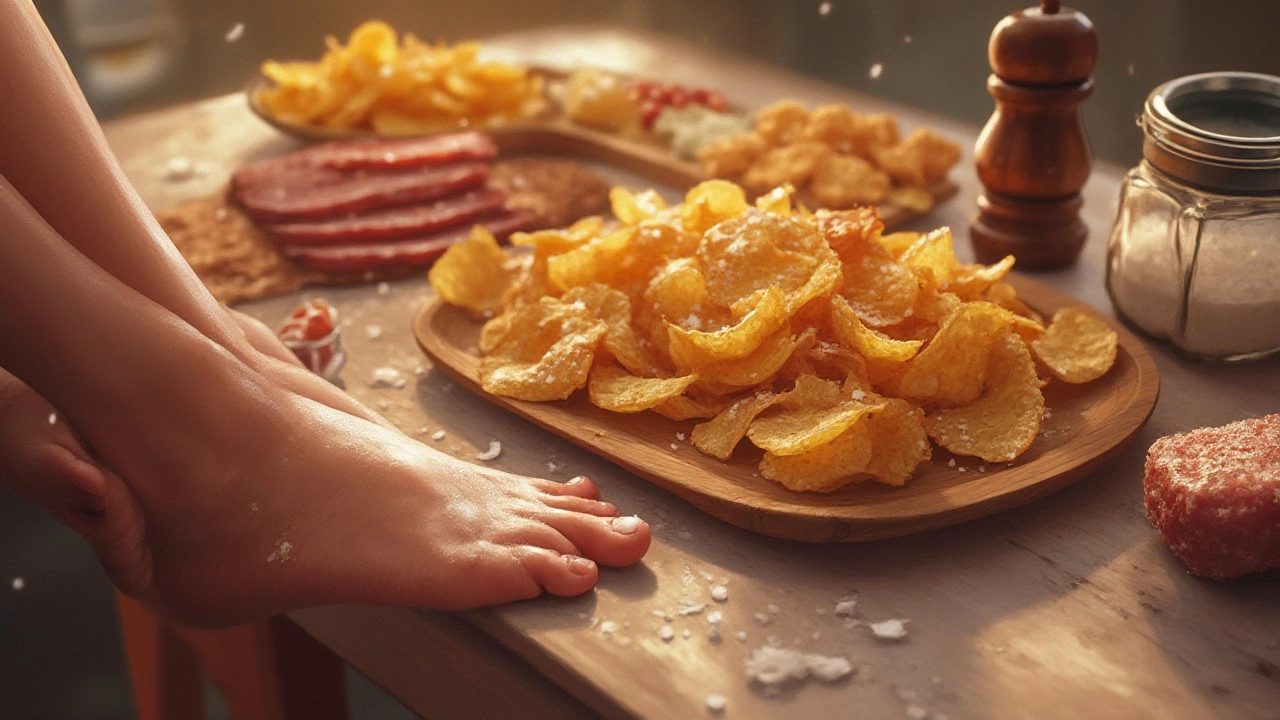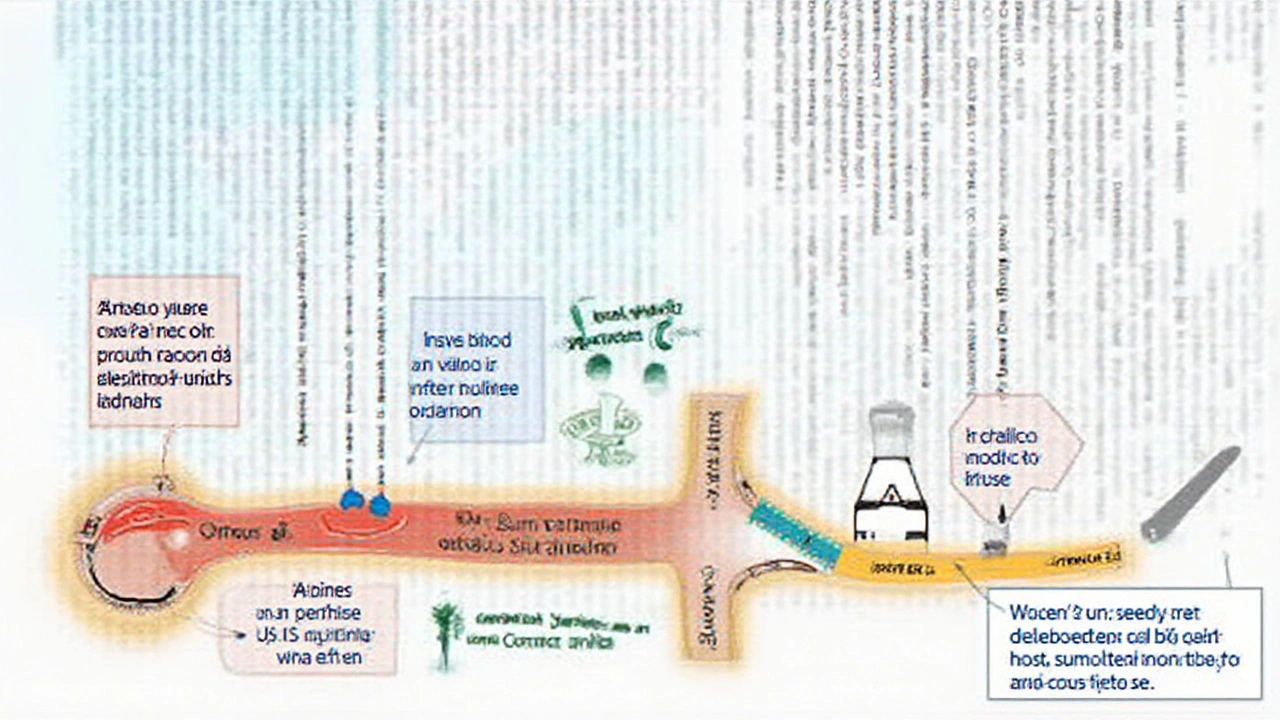How Salt Triggers Edema and Boosts Heart Risks: Cardiologists Explain

Your feet look like loaves of bread—thick, puffy, and tight by the end of a long day. You sigh, yank off your socks, and wonder: Did that ramen binge or salted popcorn do this? Cardiologists see it all the time. It’s not just cosmetic swelling—they’re quietly worried because too much salt in your diet can turn into a ticking time bomb for your heart, veins, and even your brain. It’s not about taste; it’s about pressure, both inside and out.
Why Does Salt Lead to Swelling? The Science (and Symptoms) Explained
Salt—the crystal we shake over fries or hide in frozen meals—has a big job inside the body. Its main ingredient, sodium, keeps your fluids in balance. Think of sodium like a magnet for water. When you eat more salt than your kidneys can get rid of, your body holds onto water to keep blood sodium levels steady. The extra water leaks into tissues, causing swelling, which experts call "edema." For most people, this shows up in feet, ankles, or lower legs first.
If you’ve ever seen the inside of your shoes imprinted in your skin, you’ve seen edema up close. It can sneak up after a particularly salty dinner. But let’s pause—the link doesn’t stop at poor shoe fits. Peripheral edema isn’t just a harmless nuisance for those over 60 or on their feet a lot; for many, it’s a warning sign from the heart.
Here’s where the worries multiply:
- High sodium intake forces your body to retain more fluid.
- Extra fluid means blood volume goes up, so your heart has to work harder to pump it around.
- Blood vessels get stressed, leading to higher blood pressure.
- Over time, this strain can weaken your heart muscle and damage vessels.
That swelling in your feet? It’s not just water. It’s a sign that your circulatory system is under strain, especially if you have underlying heart trouble, kidney problems, or diabetes.
| Salt Intake Level | Average Edema Severity | Associated Heart Risk |
|---|---|---|
| <1500mg/day (low) | Rare | Low |
| 2300mg/day (standard guideline) | Mild, depends on genetics/age | Moderate |
| 3500mg+/day (typical in western diets) | Common, especially in over-50s | High |
Let’s get specific: Americans on average consume more than 3400mg of sodium daily—well above heart-healthy limits set by the American Heart Association. Why the disconnect? Salt is everywhere, hiding in places you least suspect: salad dressings, canned veggies, "healthy" soups, and bread. For anyone already fighting high blood pressure or prediabetes, it’s like adding fuel to a smoldering fire.
Doctors get plenty of questions about new swelling: “Is it salty foods or something worse?” The answer is, it’s often both. For some, a big ham sandwich triggers visible swelling within a few hours. In others, the link is slower, with swelling quietly building week after week. Don’t shrug it off, especially if you notice:
- Pain or tightness in your legs
- Indentations from socks or shoes
- More swelling at the end of the day
For parents like me, seeing puffiness or weird bulges on my daughter Elora after a pizza party can be just as concerning. Even young bodies can react to sudden sodium spikes if they’re sensitive—or not drinking enough water during the day.

The Ripple Effect: Sodium’s Hidden Threats for Your Heart and Beyond
The link between “does salt cause edema” isn’t just a Google search—it’s become a clinical red flag. There’s a fascinating dive into this over at does salt cause edema with a handy explainer for detail-lovers.
What happens down at the tissue level when you eat too much salt? Water follows salt—so sodium molecules pull moisture into your blood, expanding the plasma volume. Blood pressure rises, and your tiny blood vessels (the capillaries) can’t handle the surge. Fluid leaks out into surrounding spaces. Over time, this doesn’t just trigger puffy ankles—the added pressure puts strain on your arteries, left ventricle, and even your kidneys, who are the original winners or losers in this sodium tug-of-war.
The scary bit? People who regularly eat a lot of salt have more "silent" cardiovascular damage:
- Heart muscle thickening (left ventricular hypertrophy)
- Stiffening and narrowing of arteries (atherosclerosis)
- Long-term increase in stroke risk
- Accumulation of fluid leading to congestive heart failure
It’s not just a long-term story, either. A major study from 2022 followed over 10,000 adults and found that people with higher daily sodium intake are not only more likely to develop edema, but also suffered higher rates of hospital admissions for heart failure. It takes very little: just a few extra grams of salt per day.
Kids and young adults aren’t immune. High-salt diets start the cycle early, reshaping taste buds so only heavily salted foods seem tasty. That’s not great news for the next generation—early sodium excess increases the likelihood of lifelong high blood pressure, meaning young people might lock themselves onto heart meds decades sooner than their grandparents did.
So, who is most at risk? Let’s break it down:
| Group | Why They’re Sensitive |
|---|---|
| Adults >60 | Aging kidneys; more salt-sensitive cells |
| Pregnant women | Body retains more water naturally; extra sodium can tip balance |
| People with hypertension or heart failure | Already struggling with fluid removal |
| People with kidney disease | Kidneys can't clear sodium effectively |
If you’re in one of those groups, small sodium cuts can have a huge benefit. Don’t believe the myth that our bodies “need” lots of salt—actual sodium requirements are surprisingly modest. Most of us can easily thrive on far less than we’re served each day. Give your taste buds about two weeks on a lower-sodium diet, and you’ll notice flavors bounce back in foods you thought were bland. I learned this after my own salt swap challenge for Elora—within ten days, her usual chicken noodle soup tasted almost briny to her. Her swelling? Gone before the next checkup.

Practical Steps: How to Ditch Excess Salt and Protect Your Heart (and Ankles)
If you’re staring down a possibly swollen ankle right now, you might think, “Is there really anything I can do, or is the damage done?” Good news—your body is pretty forgiving, especially if you make changes gradually. Cardiologists are nearly unanimous: nothing beats a steady, mindful reduction in salt for reversing mild edema and protecting your heart.
Here’s where it gets actionable. Don’t get stuck counting every granule—start with these tricks:
- Read labels relentlessly. Sodium hides in places that seem "healthy"—pickles, even some 'low-fat' breads.
- Switch to fresh, homemade meals where you control the seasoning.
- Use spices, garlic, lemon, and herbs to boost flavor without salt. Try black pepper, smoked paprika, or a pinch of chili for that zing.
- Rinse canned beans and veggies before eating to wash off extra sodium.
- Swap out salty snacks for raw or roasted nuts (unsalted, of course), fruits, and crunchy veggies.
- If you’re eating out, ask for sauces and dressings on the side.
There’s also an emotional side to this. Food is comfort—who wants to give up their favorite ramen after a tough day? The trick is to swap just one meal a day from packaged/processed to fresh, and you’ll notice less swelling by the end of the week. Smashed avocado sprinkled over unsalted toast, or Greek yogurt loaded with berries, beats fast food fries and a shake, especially once the habit sticks.
And remember: hydration actually helps. Counterintuitive, right? When you cut back on sodium but don’t drink enough water, your body can still cling to what’s left, leaving you puffy. Aim for two big water bottles during the day—more if you’re out in the heat or moving around a lot.
If lifestyle changes aren’t cutting it—if you notice swelling that doesn’t go away overnight, breathlessness, chest pain, or rapid weight gain—it’s time to call your doctor. Persistent edema can be your body’s way of waving a red flag for something more serious, like heart failure or kidney trouble. Cardiologists treat this as urgent, often running blood tests, checking urine sodium, or doing an echocardiogram just to see how things are running under the hood.
One last tip for parents and caregivers: get kids in the habit of tasting foods before adding salt. Most people pile on salt out of habit, not real need. Make it a game—who can spot the salt-free soup, or invent the most flavorful veggie side without the shaker?
The bottom line? Your body tells you when it’s overloaded with salt—it’s up to you to listen. A little less sodium today means less puff, more energy, and a lot less worry at your next heart checkup. And trust me: those sock lines are way easier to avoid than heart failure. Give your scales, blood pressure monitor, and favorite shoes a break—and your future self will thank you.

shawn monroe
July 24, 2025 AT 00:48Let’s be real-this isn’t just about edema, it’s about sodium-induced volume overload triggering neurohormonal activation of the RAAS axis, which then upregulates aldosterone, causing renal sodium retention and capillary hydrostatic pressure to spike. We’re talking endothelial dysfunction on a systemic level here. That puffiness in your ankles? It’s not water-it’s plasma leaking through compromised glycocalyx. And yeah, the 2022 Lancet study showed a 23% increase in HF hospitalizations per 1g/day sodium increase. This isn’t anecdotal. It’s pathophysiology.
Stop calling it ‘salt cravings.’ It’s addiction. Your taste buds are rewired by chronic hypernatremia. You think you like it? You’re just desensitized. Try a 14-day reset. Your BP will drop. Your socks won’t leave marks. Your heart will thank you. 😤🫀
marie HUREL
July 25, 2025 AT 05:27I never realized how much salt was in my ‘healthy’ oatmeal until I started reading labels. I used to think I was being good-until I saw 300mg per serving and realized I ate two bowls. Now I make my own with cinnamon, mashed banana, and a dash of vanilla. No salt. No sugar. And honestly? It tastes better. My feet don’t swell anymore after long days at the desk. It’s not about deprivation-it’s about noticing what you’re really eating. Small swaps, big changes. 🙏
Leo Adi
July 27, 2025 AT 05:15In India, we’ve been dealing with this for generations. Our moms always said, ‘Don’t eat too much salt, beta-your blood will turn thick.’ Back then, we didn’t have fancy charts or cardiologists. We had tradition. Now I see my uncle on dialysis, and I think-what if he’d cut back? We use so much salt in pickles, papads, even chai sometimes. But my cousin switched to rock salt, reduced portions, and added lemon and ginger. His BP dropped. Swelling vanished. Maybe the answer isn’t just science-it’s culture, too. We just need to listen to the old ways again.
Also, chai without salt? Still delicious. Try it.
Melania Rubio Moreno
July 28, 2025 AT 22:22ok but like… what if i just like salty food?? like i dont care if my ankles look like dough balls. its my body. why does everyone act like salt is the devil? also i think heart doctors are just trying to sell us expensive meds. 🤷♀️
Gaurav Sharma
July 30, 2025 AT 13:47It is imperative to recognize that the assertion of sodium-induced edema as a benign phenomenon constitutes a dangerous oversimplification of cardiovascular pathophysiology. Empirical data from the Framingham Heart Study and NHANES III cohorts demonstrate unequivocally that chronic sodium excess correlates with a 4.7-fold increase in left ventricular hypertrophy incidence, independent of BMI or physical activity levels. The author’s anecdotal reference to ‘Elora’ is both statistically irrelevant and emotionally manipulative. To mitigate systemic risk, a mandatory sodium audit, calibrated to renal function biomarkers, must be implemented at the population level. This is not a lifestyle choice. It is a medical imperative.